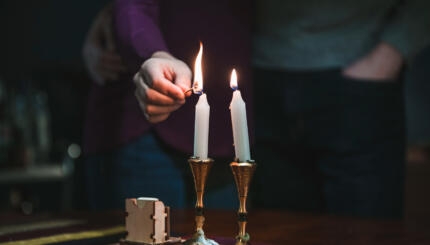What did you do this Rosh Hashanah? I spent my holiday in synagogue applying the scientific method, snacking on honey-flavored ice cream made with liquid nitrogen, playing with slime that I had just created, and observing color changes as chemicals were mixed. Isn’t that what everyone does on Rosh Hashanah?!
Clearly it’s not. And yet, that’s how our service for all ages was spent at Congregation Beth Adam in Cincinnati. I led services there along with a chemistry professor from a local university. Yes, we read liturgy and sang together and talked about the symbols of the holiday, but we also did science, and here’s why.
As a rabbi, I always want to help students of all ages distinguish between myths and reality. While Jewish legends are a central and wonderful component of Judaism, it’s important to differentiate between fact and fiction. At the beginning of services, we handed students a so-called “fortune teller miracle fish.” These fish are made of cellophane, a polymer used in transparent food packaging, floral sleeves, and gift wrapping. The fish instantly curls in your hand since it’s responding to the moisture. Once students observed this, we pointed out that this is not a “miracle,” this is simply science.
Miracles are not science, and yet miracles make for wonderful stories and legends. When teaching Torah to young students, I explain that our ancestors had little scientific understanding compared to what we have today. So, when something happened that they couldn’t explain, they often created stories to explain the particular event. Those myths are creative and profound and give us a glimpse into our ancestors’ ways of thinking – they are incredible stories to read and reread.
I believe Jewish communities are stronger when we embrace not only religious learning but scientific learning as well. The sanctuary at Congregation Beth Adam, where I worked for nine years and where I returned for this Rosh Hashanah, is filled with science. The stained glass windows represent the Big Bang. The eternal light has a double helix representing DNA above it. And it’s a sanctuary in which we talk about science regularly, always making clear that when Judaism and science disagree with each other, we side with science.
The reality is that although we symbolically entered the year 5776, we know the world is actually billions of years old. Students need to understand that from an early age. As an educator, I work hard not to teach students anything I’ll have to “un-teach” them later. That means sharing legends and myths, but being explicit that that’s what they are. To do so doesn’t make them any less interesting – in fact, the creativity is to be celebrated.



